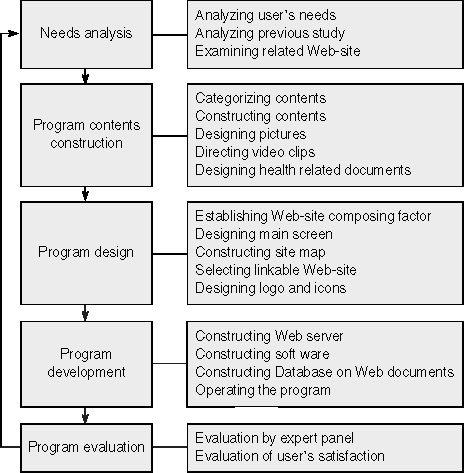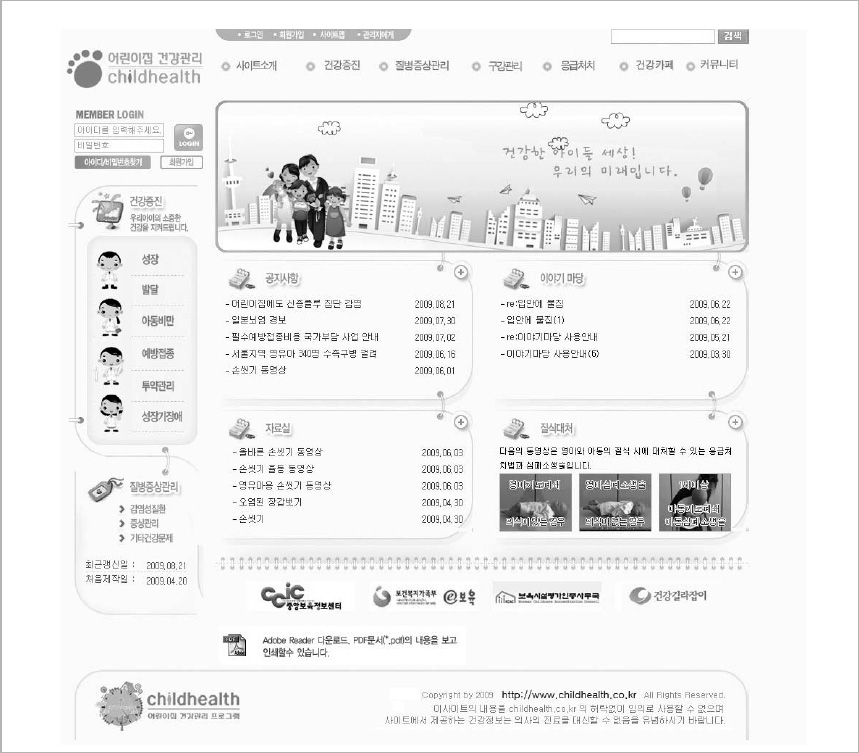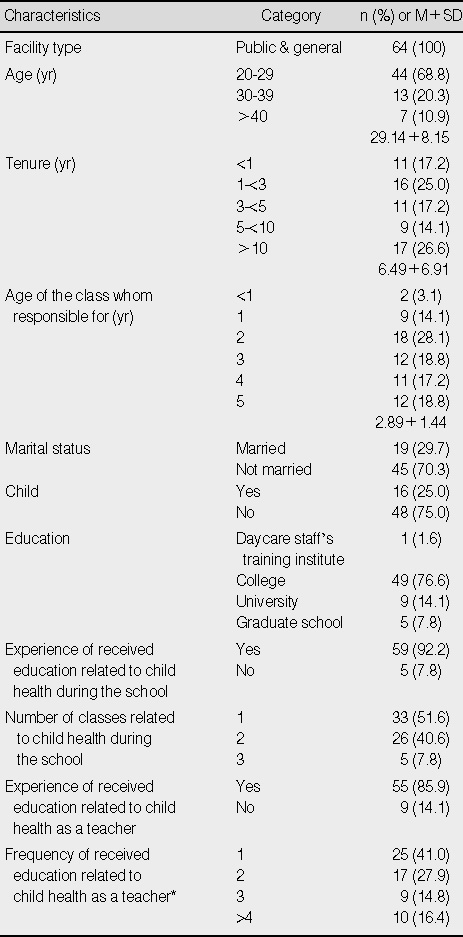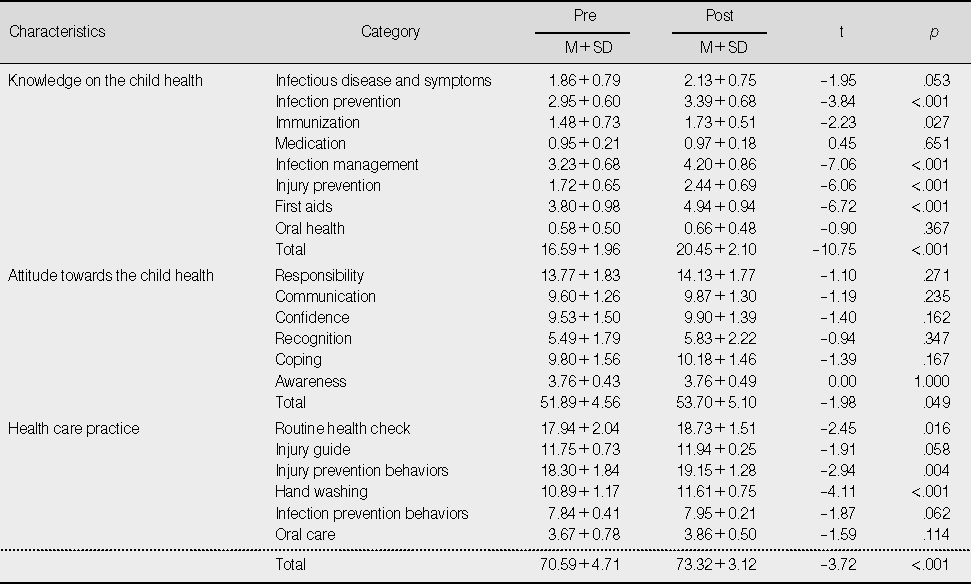Articles
- Page Path
- HOME > J Korean Acad Nurs > Volume 40(2); 2010 > Article
-
Original Article
- Development and Effect of a Web-based Child Health Care Program for the Staff at Child Daycare Centers
- Ji Soo Kim
-
Journal of Korean Academy of Nursing 2010;40(2):213-224.
DOI: https://doi.org/10.4040/jkan.2010.40.2.213
Published online: April 30, 2010
Assistant Professor, Department of Nursing, Gachon University of Medicine and Science, Incheon, Korea.
- Address reprint requests to: Kim, Ji Soo. Department of Nursing, Gachon University of Medicine and Science, 534-2 Yeonsu-dong, Yeonsu-gu, Incheon 406-799, Korea. Tel: 82-32-820-4206, Fax: 82-32-820-4201, jskim@gachon.ac.kr
• Received: December 2, 2009 • Revised: December 7, 2009 • Accepted: March 18, 2010
Copyright © 2010 Korean Society of Nursing Science
Abstract
-
Purpose
- The purpose of the study is to develop a web-based program on child health care, and to identify the effect of the program on knowledge of, attitudes towards child health care, and health care practice in staff of daycare centers.
-
Methods
- The program was developed through the processes of needs analysis, contents construction, design, development, and evaluation. After the program was developed, it was revised through feedback from 30 experts. To identify the effect of developed program, onegroup pretest-posttest design study was conducted with 64 staff members from 12 daycare centers in Korea.
-
Results
- The program was developed based on users' needs and consisted of five parts: health promotion, disease and symptoms management, oral health, injury and safety, sheets and forms. This study showed that the total score of staff who used the program was significantly higher in terms of knowledge, attitudes, and their health care practice compared with pretest score (p<.05).
-
Conclusion
- These results suggest that this Web-based program can contribute to the child health promotion as well as can provide the staff with the insightful child health information. Therefore, it is expected that this program will be applied to staff of other child care settings for children's health.
- 1. Ahn SG. A study on user's satisfaction of the agriculture information system. 1999;Seoul, Seoul National University. Unpublished doctoral dissertation.
- 2. American Academic of Pediatrics. Caring for our children. national health and safety performances standards: Guidelines for out-of-home child care programs. 2002;2nd ed. Washington DC, Author.
- 3. American Academic of Pediatrics. Bright futures. 2008;Retrieved January 14, 2010. from http://brightfutures.aap.org/pdfs/Guidelines_PDF.
- 4. Bang KS. Attitude, knowledge, and practice of safety and related factors of teachers in child care centers. Korean Journal of Child Health Nursing. 2005;11:43–53.
- 5. Benfield JP. The effect of a teaching program on infection prevention behavior in day care center staff members. 1991;Washington DC, USA, The Catholic University. Unpublished doctoral dissertation.
- 6. Choi JS, Kim KS. Application and evaluation of a web-based education program on blood-borne infection control for nurses. Journal of Korean Academy of Nursing. 2009;39:298–309.ArticlePubMed
- 7. Chung YC, Park HA. Development of a health information evaluation system on the internet. Journal of Korean Society of Medical Informatics. 2000;6:53–66.ArticlePDF
- 8. Cohen J. Statistical power analysis for the behavioral sciences. 1988;2nd ed. Hillsdale, NJ, Erlbaum.
- 9. Doll WJ, Torkzadeh G. The measurement of enduser computing satisfaction. MIS Quarterly. 1998;12:257–274.
- 10. Infante-Rivard C, Amre D, Gautrin D, Malo J. Family size, day-care attendance, and breastfeeding in relation to the incidence of childhood asthma. American Journal of Epidemiology. 2001;153:653–658.ArticlePubMedPDF
- 11. Increasing accidents at child daycare centers. Joins news. 2008;10 07 Retrieved October 27, 2009. from http://article.joins.com/article/article.asp.
- 12. Kim HS, Lee CY, Lee TW, Ham OK. Health problems and health behaviors of preschoolers. Journal of Korean Academy of Nursing. 2004;34:182–190.ArticlePubMedPDF
- 13. Kim HY. A case study of pre-daycare teachers' knowledge on health and its practice. 2002;Seoul, Dongduk Women's University. Unpublished master's thesis.
- 14. Kim JS. A survey of children's health needs in child care centers among teachers. 2004;Seoul, Seoul National University. Unpublished master's thesis.
- 15. Kim JS. The effect of an infection prevention program in child day-care centers. 2007;Seoul, Seoul National University. Unpublished doctoral dissertation.
- 16. Kim JS. Evaluation of internet web-sites providing infant health related information for daycare staffs. The Journal of the Korea Contents Association. 2010;10:334–342.Article
- 17. Kim JW, Kim YJ, Bae IJ. A study on the needs of infant/toddler caregivers' for the in-service education programs. Journal of Young Child Studies. 2002;5:139–159.
- 18. Kotch JB, Weigle KA, Weber DJ, Clifford RM, Harms TO, Loda FA, et al. Evaluation of an hygienic intervention in child day-care centers. Pediatrics. 1994;94:991–994.ArticlePubMedPDF
- 19. Lee ES, Kim CN. A study on the occurrences of accidents among children in nursery school and kindergartens. Journal of Korean Academy of Public Health Nursing. 2003;17:96–112.
- 20. Lim NY, Kim JH, Chon JJ, Jung MH, Kim BH, Yoo EK, et al. Development model of child health promotion center. Korean Nurse. 2003;42(5):74–82.
- 21. Lu N, Samuels ME, Shi L, Baker SL, Glover SH, Sanders JM. Child day care risks off common infectious diseases revisited. Child: Care, Health and Development. 2004;30:361–368.PubMed
- 22. Manning A. Preventing and managing illness in child care setting: A program evaluation. 1995;St. John's, Newfoundland & Labrador, Canada, Memorial University. Unpublished master's dissertation.
- 23. Masuda K, Masuda R, Nishi JI, Tokuda K, Yoshnaga M, Miyata K. Incidences of nasopharyngeal colonization of respiratory bacterial pathogens in Japanese children attending day-care centers. Pediatrics International. 2002;44:376–380.ArticlePubMed
- 24. Ministry for Health, Welfare and Family Affairs. Statistics on child care programme. 2008;12 31 Retrieved October 11, 2009. from http://www.stat.mw.go.kr.
- 25. Ministry for Health, Welfare and Family Affairs. Law on child care programme. 2009;03 10 Retrieved October 11, 2009. from http://www.law.go.kr.
- 26. Nam HK. Safety diagnosis and program development for the prevention of injuries at child care centers. 2002;Seoul, Chungang University. Unpublished doctoral dissertation.
- 27. Oh KS, Sim MK, Choi EK. Knowledge, self-confidence and practice of teachers concerning health and safety of children in child-daycare centers. Korean Journal of Child Health Nursing. 2008;14:155–162.
- 28. Oh KS, Sim MK, Choi EK. Effect of an education program on child health and safety for child care teachers. Korean Journal of Child Health Nursing. 2009;15:5–14.Article
- 29. Sohn AR. Criteria for evaluating health information sites on the internet. Journal of the Korean Society of Health Statistics. 2000;25(2):97–107.
- 30. Statistics Korea. Population on projections. 2006;11;Retrieved October 11, 2009. from http://www.kosis.kr/domestic/theme/do01_index.jsp.
REFERENCES
Figure & Data
REFERENCES
Citations
Citations to this article as recorded by 

- The development and effects of an online-based community psychiatric nursing practice program with the ARCS model
Pan Heui Kim, Hee Sook Kim
The Journal of Korean Academic Society of Nursing Education.2024; 30(1): 5. CrossRef - Effect of Visiting and a Smartphone Application Based Infection Prevention Education Program for Child Care Teachers: A Non-Randomized Controlled Trial
Yun Jeong Yang, In Soo Kwon
Journal of Korean Academy of Nursing.2017; 47(6): 744. CrossRef - Development of Postoperative Self Care Mobile App for Kidney Transplantation Patients
Se-Hee Noh, Jeong-Sook Park
Journal of the Korea Academia-Industrial cooperation Society.2016; 17(12): 316. CrossRef - The effect of a web‐based education programme (WBEP) on disease severity, quality of life and mothers' self‐efficacy in children with atopic dermatitis
Hae Kyoung Son, Jiyoung Lim
Journal of Advanced Nursing.2014; 70(10): 2326. CrossRef - Development of an Ecological Model to Improve Health Care Management for Children in Child Care Centers.
Eun Sook Park, Yeo Jin Im, Eun Ji Cho
Child Health Nursing Research.2013; 19(1): 59. CrossRef - Health Issues and Management for Children with Disabilities attending Daycare Centers
Ji-Soo Kim
Journal of Korean Academy of Child Health Nursing.2012; 18(3): 127. CrossRef - Development and Effects of an e-Learning Program in Operating Room Nursing for Nursing Students
Eun Hee Park, Seon Young Hwang
Journal of Korean Academy of Nursing.2011; 41(1): 36. CrossRef
Development and Effect of a Web-based Child Health Care Program for the Staff at Child Daycare Centers


Figure 1
Process of program development.
Figure 2
Main screen of the web site providing health care information for the staff at child daycare centers.
Figure 1
Figure 2
Development and Effect of a Web-based Child Health Care Program for the Staff at Child Daycare Centers
General Characteristics and Information Needs of the Child Daycare Centers Staff (N=113)
* Missing value excluded; † Multiple response.
General Characteristics of the Subjects (N=64)
* Missing value excluded.
Comparison of the Knowledge, Attitude and Practice on the Child Health after Web-based Program (N=64)
Table 1
General Characteristics and Information Needs of the Child Daycare Centers Staff (N=113)
* Missing value excluded; † Multiple response.
Table 2
General Characteristics of the Subjects (N=64)
* Missing value excluded.
Table 3
Comparison of the Knowledge, Attitude and Practice on the Child Health after Web-based Program (N=64)
 KSNS
KSNS
 E-SUBMISSION
E-SUBMISSION





 Cite
Cite

